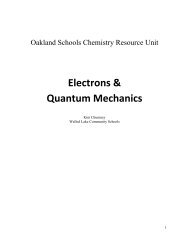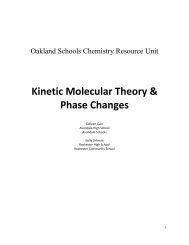Nomenclature and Chemical Reactions - Oakland Schools
Nomenclature and Chemical Reactions - Oakland Schools
Nomenclature and Chemical Reactions - Oakland Schools
You also want an ePaper? Increase the reach of your titles
YUMPU automatically turns print PDFs into web optimized ePapers that Google loves.
Binary Molecular Compounds<br />
Usually consists of 2 nonmetals. Names use prefixes to indicate subscripts.<br />
Names still use –ide endings<br />
1=mono 2=di 3=tri 4=tetra 5=penta etc.<br />
Ex. CO<br />
N 2 O 4<br />
PCl 3<br />
SCl 6<br />
N 2 O 3<br />
carbon monoxide<br />
dinitrogen tetraoxide<br />
phosphorus trichloride<br />
sulfur hexachloride<br />
dinitrogen trioxide<br />
Writing Formulas – Ionic Compounds<br />
Steps:<br />
1) Write symbols for each ion.<br />
2) Determine charge of each ion.<br />
3) Add more of either ion, as needed in order to get a neutral charge on the<br />
compound.<br />
4) Put parentheses around polyatomic ions.<br />
5) Subscripts indicate the number of each ion used.<br />
EX: calcium iodide<br />
Ca I Ca +2 I -1 CaI 2<br />
EX: aluminum sulfate<br />
Al SO 4 Al +3 SO 4<br />
-2<br />
Al 2 (SO 4 ) 3<br />
Endothermic <strong>and</strong> Exothermic <strong>Reactions</strong>:<br />
Use the terms endothermic <strong>and</strong> exothermic to describe chemical reactions in which heat<br />
is transferred between the system <strong>and</strong> surroundings. Possible demos/reactions include<br />
zinc or magnesium with hydrochloric acid or steel wool with vinegar for exothermic.<br />
Endothermic reactions would be vinegar with baking soda or ammonium chloride with<br />
barium hydroxide.<br />
<strong>Reactions</strong> either release or absorb energy based on the net energy change of the<br />
bonds.<br />
5
















